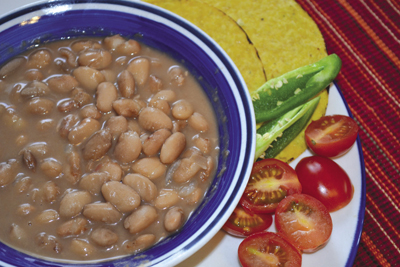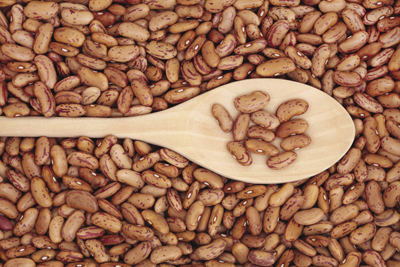Using Pinto Beans
Guide E-213
Revised by Nancy C. Flores and Cindy Schlenker Davies
College of Agricultural, Consumer and Environmental Sciences, New Mexico State University
Authors: Respectively, Extension Food Technology Specialist, Department of Extension Family and Consumer Sciences; and County Program Director and Extension Home Economist, Bernalillo County Extension Office, New Mexico State University. (Print friendly PDF)
Introduction
The pinto bean, one of many types of the common bean (Phaseolus vulgaris), is one of the Americas’ gifts to the world. Beans were domesticated in Peru and Mexico around 8,000 to 7,000 years ago. They are just as popular today because of their flavor, cost, nutritional value, and ease of preparation.
Few foods are as versatile as pinto beans. They can be served as appetizers, soups, salads, main dishes, and breads. Even some cake, pie, and candy recipes use cooked pinto beans.

(NMSU photo by Susan B. Portillo)
Nutritional Value
Pinto beans are a good source of protein, vitamins, and minerals. One quarter cup of cooked pinto beans counts as 1 ounce in the protein foods group, while 1 cup of cooked beans counts as 1 cup in the vegetable group (www.ChooseMyPlate.gov). Supplementing the protein of pinto beans with a little meat, dairy, rice, or corn will provide all the essential amino acids. Because beans contain soluble fiber, they can lower blood cholesterol.
Pinto beans are a good source of protein, fiber, micronutrients, antioxidants, iron, potassium, magnesium, calcium, phosphorus, and the B vitamins folate, thiamin, riboflavin, and niacin. One half cup of cooked pinto beans provides 118 calories. Beans are good for low-sodium diets since they contain only the salt added by the cook. Beans are naturally low-fat and provide 5 grams of fiber in a 1/2-cup serving.
However, beans contain several complex carbohydrates that are not readily digested. To increase digestibility and reduce intestinal distress, discard the water used for soaking and cooking because much of the in gestible carbohydrates dissolve into the water. For best results, discard and replace water several times during soaking. Studies have shown that no important amounts of essential nutrients are lost when the soaking and cooking water are discarded before consumption.
Storage
You can easily store dried beans in tightly covered containers in a dry, cool place; they will keep for several months when stored under these conditions. Older beans will require longer soaking and cooking periods than freshly harvested beans, especially in drier climates.
Cooking Techniques
Dry beans can be cooked quickly in a pressure cooker or microwave oven, or they can be cooked slowly in a crockpot or a saucepan on the stovetop.
Sort the beans to remove small stones, lumps of dirt, and damaged or defective beans. Wash the beans with several changes of water until the water runs clear.
Soak beans to reduce cooking time, using 5 cups of hot water for each cup of beans. For a quick soak, add beans to water in a saucepan and bring to a boil for 2 minutes. Remove from heat, cover, and let stand for one hour. For overnight soaking, cover beans with cold water and refrigerate.
Discard soaking water, replace with fresh water, and cook the beans in one of the following ways. (Note: When cooking in the microwave, on the stovetop, or in a crockpot, never fill the pan more than half full.)
Pressure cooker: Add soaked, rinsed beans to a pressure cooker and add enough fresh water to cover the beans. Add 1 teaspoon of vegetable oil to prevent foaming. Do not fill the cooker more than one-third full. Follow the pressure cooker instructions for cooking and cooling process. Keep in mind, though, that beans will be cooked quickly at 15 pounds of pressure for 25 minutes.
Microwave: Place soaked, rinsed beans in fresh water and cook at full power for 8–10 minutes or until boiling, then cook at 50% power for 15–20 minutes or until beans are tender. Follow instructions on pan if using a microwave pressure cooker.
Stovetop saucepan: Cover soaked, rinsed beans with fresh water and bring to a rapid boil, then reduce heat to simmer. Cover and cook until tender, but not mushy. Add water if necessary. Total cooking time will depend on water hardness and altitude, usually 2–3 hours.
Crockpot: Follow manufacturer’s directions. If directions are not available, add fresh water to soaked, rinsed beans and heat to boiling, then reduce heat to simmer. Cook until tender, which may take 4–6 hours. After cooking, drain cooking water, add either fresh water or chicken broth, and heat to serving temperature.
Tips For Success
- To prevent skins from bursting, simmer gently and stir as little as possible.
- Increase cooking time in high altitude and/or hard water areas
- Cook the full contents of smaller packages of beans, such as the 1-pound size
- Refrigerate leftover cooked beans; drain cooked or canned beans before freezing.
- Store dry beans in airtight glass or metal containers in a cool place
- Add 1/8 to 1/4 teaspoon of baking soda per cup of beans to shorten cooking time in hard water, or use distilled water. Excess soda will cause an undesirable flavor and loss of nutrients
- A teaspoon of sugar and a clove of garlic enhance the flavor of plain, cooked pinto beans.
- If a recipe calls for tomatoes, lemon juice, wine, or vinegar, add when beans are almost tender. Acid delays softening and increases cooking time.
- A 1-pound package of dry beans is equivalent to 2 cups dry or 5–6 cups cooked beans.

(© Marilyn Barbone | Dreamstime.com )
Recipes
Frijoles Refritos—Refried Beans
Add 1/2 to 1 tablespoon of oil to 3 cups of cooked, mashed pinto beans in a large skillet. Mix well and cook, stirring until the desired consistency is obtained. Add more liquid if necessary. Serve as a side dish or use as a filling for bean burritos, tostadas, or tacos.
Bean Tostadas
12 6-inch tostadas or tortillas, fried crisp and flat or heated quickly in a 450°F oven
4 cups refried beans
3 cups shredded cheddar or Monterey Jack cheese
1 cup shredded lettuce
1 large tomato, chopped
1 medium avocado, peeled and cut into 12 wedges
Salsa of your choice
Preheat oven to 350°F. Arrange tostadas in a single layer on a cookie sheet. Spoon 1/3 cup refried beans on each tostada. Sprinkle with cheese. Bake for 10 minutes or until cheese is melted. Top each tostada with lettuce, tomato, and avocado. Season with salsa if desired.
Baked Pinto Beans
3 cups dry pinto beans
1 medium onion, sliced
3 cups water or unsalted chicken stock
2 level teaspoons salt
1 heaping teaspoon prepared mustard
1/4 teaspoon black pepper
1 teaspoon Worcestershire sauce
1/3 cup molasses
1/4 cup brown sugar
1/8 pound bacon or salt pork, diced
Cook soaked beans on low heat until tender. Drain and rinse beans.
Preheat oven to 300°F. Add onion slices to bottom of bean pot, then add drained beans. Mix remaining ingredients, except meat, with water or chicken stock and pour over beans. Carefully stir diced meat into bean mixture. Place in oven and bake for 2 1/2 hours; uncover for the last 1/2 hour. Add water if necessary.
Ensalada de Frijol—Pinto Bean Salad
2 cups cooked and rinsed pinto beans
1/2 cup diced celery
3 green chile peppers (canned or fresh)
2 medium cucumber pickles, chopped
1/2 small onion, chopped
2 tablespoons prepared mustard
4 tablespoons canned milk
Salt and pepper to taste
Mix all ingredients thoroughly except mustard and milk. Beat mustard and milk together, then add to the bean mixture. Serve on lettuce. Sprinkle top with red chile powder if desired.
Chuck Wagon Chow
1 pound beef chuck or round, cut into 1-inch cubes
2 tablespoons chile powder
1 1/2 teaspoons salt
1/4 teaspoon pepper
1 clove garlic, minced
1 tablespoon salad oil
1 cup chopped onion
1 4-ounce can chopped green chile
2 cups cooked and rinsed pinto beans
1 can whole kernel corn
Sprinkle beef cubes with chile powder, salt, and pepper. Slowly brown the meat and garlic in the salad oil in a large frying pan.
Add onions and green chile and cook over low heat for 10 minutes, stirring often.
Drain pinto beans and corn and reserve the drained liquid. Add reserved liquid to meat mixture, cover, and simmer 45 minutes or until meat is tender.
Add pinto beans and corn; cover and cook over low heat for 10 minutes, stirring often.
Mock Pumpkin Pie
2 cups pinto bean purée*
3 eggs
1 13-ounce can evaporated milk
1 cup sugar
3/4 teaspoon salt
1 teaspoon ground cinnamon
1 teaspoon ground ginger
1/4 teaspoon ground cloves
1/4 teaspoon ground nutmeg
1 9-inch unbaked pie shell
*Use tender, cooked, unseasoned pinto beans. Rinse well and purée 2 cups beans with 1/4 to 1/2 cup water or unsalted chicken stock in a blender until smooth. Scrape down sides occasionally.
Preheat oven to 425°F. Mix together ingredients in the order listed. Pour into pie shell. Bake for 15 minutes. Reduce temperature to 350°F and continue baking for 45 minutes or until a knife inserted into the center of pie filling comes out clean. Cool. Garnish with whipped cream if desired.
No-Cook Pinto Bean Fudge
1 cup warm, cooked pinto beans
3/4 cup melted butter or margarine
1 cup cocoa powder
1 tablespoon vanilla
2 pounds powdered sugar
1 cup chopped pecans (optional)
Mash or sieve beans. Add melted butter or margarine, cocoa powder, and vanilla. Mix in powdered sugar gradually. Add nuts if desired. Press into a 9 x 13-inch oiled or nonstick pan. Store in the refrigerator until fudge has hardened.
For more on this topic, see the following publications:
E-508: Keeping Food Safe
https://pubs.nmsu.edu/_e/E508/
E-118: Storing Food Safely
https://pubs.nmsu.edu/_e/E118/
E-323: Salsa Recipes for Canning
https://pubs.nmsu.edu/_e/E323/
Original authors: Mae Martha Johnson, Extension Food and Nutrition Specialist, with later contributions by Alice Jane Hendley and Martha Archuleta, both Extension Food and Nutrition Specialists.

Nancy Flores is the Extension Food Technology Specialist in the Department of Extension Family and Consumer Sciences at NMSU. She earned her B.S. at NMSU, M.S. at the University of Missouri, and Ph.D. at Kansas State. Her Extension activities focus on food safety, food processing, and food technology.

Cindy Schlenker Davies is the County Program Director and Extension Home Economist at NMSU’s Bernalillo County Extension Office. She earned her B.S. at Eastern New Mexico University and her M.A. at NMSU. Her Extension and public outreach work focuses on food processing and preservation and food safety.
To find more resources for your business, home, or family, visit the College of Agricultural, Consumer and Environmental Sciences on the World Wide Web at pubs.nmsu.edu
Contents of publications may be freely reproduced for educational purposes. All other rights reserved. For permission to use publications for other purposes, contact pubs@nmsu.edu or the authors listed on the publication.
New Mexico State University is an equal opportunity/affirmative action employer and educator. NMSU and the U.S. Department of Agriculture cooperating.
Revised September 2015


